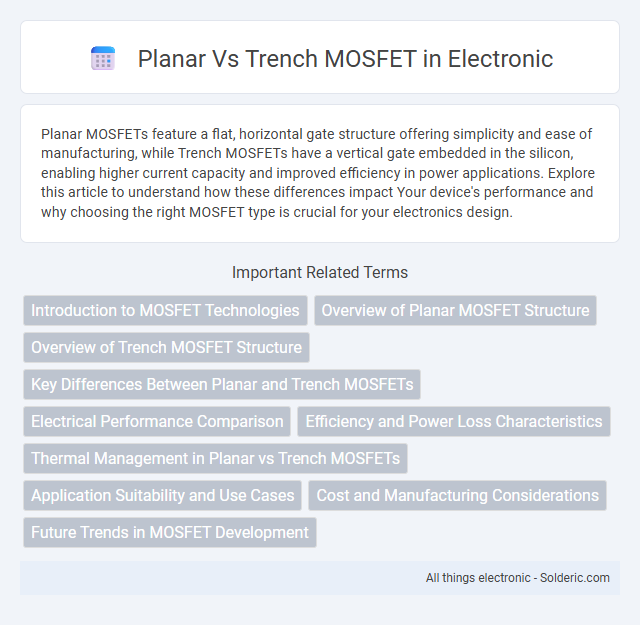Planar MOSFETs feature a flat, horizontal gate structure offering simplicity and ease of manufacturing, while Trench MOSFETs have a vertical gate embedded in the silicon, enabling higher current capacity and improved efficiency in power applications. Explore this article to understand how these differences impact Your device's performance and why choosing the right MOSFET type is crucial for your electronics design.
Comparison Table
| Feature | Planar MOSFET | Trench MOSFET |
|---|---|---|
| Structure | Flat, surface-level channel | Vertical channel in a trench |
| On-Resistance (R_DS(on)) | Higher due to lateral current flow | Lower due to vertical current path |
| Cell Density | Limited by surface area | Higher due to vertical design |
| Switching Speed | Moderate | Faster switching capabilities |
| Gate Control | Planar gate electrode | Trench gate, better electrostatic control |
| Applications | Low-power, general use | Power electronics, high efficiency |
| Cost | Lower manufacturing complexity, cheaper | Higher cost due to complex fabrication |
Introduction to MOSFET Technologies
Planar MOSFETs feature a flat channel structure where current flows laterally between the source and drain, providing simplicity and ease of manufacture for low to medium power applications. Trench MOSFETs incorporate vertical channel designs with deeper trenches etched into the silicon substrate, allowing higher current density, lower ON-resistance, and improved switching performance, especially in high-power and high-frequency circuits. The transition from planar to trench technology reflects advancements in semiconductor fabrication that optimize device scalability, efficiency, and thermal management in modern power electronics.
Overview of Planar MOSFET Structure
Planar MOSFETs consist of a flat semiconductor surface with source, drain, and gate regions arranged laterally. The gate electrode controls current flow by creating an electric field that modulates the conductivity of the channel beneath the gate oxide. This simple, well-established structure provides reliable switching performance and easy integration for low to medium power applications.
Overview of Trench MOSFET Structure
Trench MOSFETs utilize a vertical gate structure etched into the silicon substrate, allowing for higher cell density and lower on-resistance compared to planar MOSFETs. This design enhances switching performance and reduces conduction losses, making it ideal for power-efficient applications. Understanding the trench MOSFET structure helps optimize your device selection for improved thermal management and electrical efficiency.
Key Differences Between Planar and Trench MOSFETs
Planar MOSFETs feature a horizontal channel and surface gate structure, while Trench MOSFETs use a vertical channel with a trench gate design for reduced on-resistance and improved efficiency. The trench design offers higher current density and smaller chip size, making it ideal for high-performance power applications. Understanding these key differences helps you select the right MOSFET type based on switching speed, footprint, and thermal management requirements.
Electrical Performance Comparison
Trench MOSFETs deliver superior electrical performance compared to planar MOSFETs, exhibiting lower on-resistance (R_DS(on)) and higher current-carrying capability due to their vertical channel structure that maximizes silicon utilization. The reduced channel length and enhanced gate control in trench designs result in faster switching speeds and lower gate charge, improving efficiency in power applications. Planar MOSFETs typically show higher parasitic capacitances and greater conduction losses, making trench MOSFETs preferable for high-frequency, high-current environments.
Efficiency and Power Loss Characteristics
Trench MOSFETs exhibit higher efficiency and lower power loss compared to Planar MOSFETs due to their vertical channel structure, which allows for reduced on-resistance (R_DS(on)) and improved current flow. The compact cell design in Trench MOSFETs minimizes conduction and switching losses, enhancing overall device performance in high-frequency applications. Your system benefits from these characteristics by achieving better thermal management and energy-saving capabilities.
Thermal Management in Planar vs Trench MOSFETs
Planar MOSFETs typically exhibit lower thermal resistance due to their simpler structure, enabling efficient heat dissipation across the device surface. Trench MOSFETs, while offering higher current density and switching performance, can face challenges in thermal management because heat generation is concentrated within the vertical trench regions. Ensuring effective thermal management in your application involves balancing the enhanced electrical performance of trench MOSFETs with the potentially improved heat dissipation characteristics of planar designs.
Application Suitability and Use Cases
Planar MOSFETs excel in low-voltage, high-frequency applications such as analog circuits and power management in consumer electronics due to their simpler fabrication and cost-effectiveness. Trench MOSFETs are preferred for high-current, high-efficiency power conversion in electric vehicles, server power supplies, and industrial motor drives because of their lower on-resistance and improved thermal performance. The choice depends on factors like voltage rating, switching speed, thermal constraints, and overall system efficiency requirements.
Cost and Manufacturing Considerations
Planar MOSFETs generally offer lower manufacturing costs due to established, simpler fabrication processes and mature technology with high yields. Trench MOSFETs, while more expensive to produce because of complex etching and deposition steps, provide better performance at higher efficiencies, which can justify the initial investment for power-sensitive applications. The choice between planar and trench MOSFET manufacturing depends on cost constraints, production volume, and performance requirements.
Future Trends in MOSFET Development
Future trends in MOSFET development emphasize the increasing adoption of trench MOSFETs due to their enhanced current density and lower on-resistance compared to planar MOSFETs. Innovations in materials such as silicon carbide (SiC) and gallium nitride (GaN) are driving efficiency improvements, enabling higher power handling and thermal performance. Your choice of MOSFET technology will likely shift towards trench designs for applications demanding superior performance and miniaturization.
Planar vs Trench MOSFET Infographic

 solderic.com
solderic.com